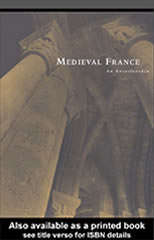
Authors : Bruckner Matilda T. - Fassler Margot - Stoddard Whitney S. - Clark William W. - Knight Alan E. - Rosenstein Roy S.
Title : Medieval France An Encyclopedia
Year : 1995
Link download : Medieval_France_An_Encyclopedia.zip
Medieval France: An Encyclopedia is an introduction to the political, economic, social, religious, intellectual, literary, and artistic history of France from the early 5th century to the late 15th. We have sought to present in a single, convenient reference work aspects of medieval France that are otherwise treated in separate scholarly publications. The subject matter is complex and vast, and we therefore make no claims for completeness. We hope, however, to have provided a balanced, informative, and up-to-date reference work that, although directed primarily toward students and the general public, will also provide a useful starting point for scholars in various disciplines. Entries range from about fifty words to over 3,000. Shorter entries provide ready reference; longer entries explain and interpret major institutions, writers and works, movements, and monuments. The encyclopedia offers a cross-disciplinary focus that promotes the integration of materials, provides a synthetic perspective, and encourages immediate connections among fields often held in isolation. Though scholars using this volume will be familiar with the basic information and bibliography contained in articles that cover their areas of expertise, they will find the articles in fields other than their own to be indispensible for general orientation, interpretation, and bibliography. The index at the end of the volume and cross-referencing at the end of each entry are designed to enhance the cross-disciplinary perspective. Both “medieval” and “France” require definition. By “medieval,” we mean that vast period between the fall of the Roman Empire, with the decline or loss of such Roman institutions as schools, roads, towns, and law—in short, civilization as we conceive it— and the advent of the Renaissance in late 15th-century France. It is a period in which a new and specifically French civilization and identity were forged, in which new institutions were conceived and developed: the universities, the feudal monarchy, scholastic philosophy, Romanesque and Gothic art, western monasticism and mysticism. Paris, which under the Capetians became the capital of a growing dynasty, was the intellectual, artistic, and political center of late-medieval France. But “France” itself is an elusive geographical area during the period in question. For purists, it is no more than the Île-de-France, the region immediately surrounding the capital. But for our purposes, it extends roughly from Brussels to the Mediterranean, from Switzerland to Brittany, and briefly even into Britain: all the area that was dominated by the new court culture that grew out of the Carolingian and Capetian intellectual centers. Individuals who played a dominant role in medieval French political, artistic, or intellectual life, and who are associated chiefly with French cultural centers, whether or not they happened to have been born within the boundaries of contemporary France, are included—for example, Peter Lombard, Thomas d’Angleterre, Thomas Aquinas, Hugh of Saint-Victor, Robert de Courçon, among many others. Entries are arranged alphabetically. In the listing of literary works, preference has been given to the names of the authors, whenever known, rather than to titles of works. Thus, Perceval (Conte du Graal) will be found under CHRÉTIEN DE TROYES and the Gesta Francorum under AIMOIN DE FLEURY. The form of the individual’s name chosen to alphabetize has frequently proven problematic. At the conception of the project, it was the editors’ intention to use the modern French form for all proper nouns, but it quickly became clear that both scholars and the general public would be disoriented, and perhaps shocked, to have to look under GUILLAUME LE BÂTARD for the familiar William the Conqueror, or PIERRE LE CHANTRE for Peter the Chanter. The compromise reached was that we would seek to include that form of the name most familiar to scholars in historical disciplines and to the general public. Thus, all kings of France and England, dukes of Burgundy, and many members of the royal families are found under their Englished form (Charles the Bad, Philip the Bold, Henry II); most theologians and philosophers are anglicized (Philip the Chancellor, William of Champeaux, Thierry of Chartres); while all vernacular authors are found under the usual French form of their name (Marie de France, Thomas d’Angleterre, Peire Cardenal). In all cases, however, the user should try the following equivalencies when the name is not where initially sought: Gautier=Walter; Guillaume/ Guilhem=William; Jean=John; Matthieu=Matthew; Philippe=Philip; Pierre/Peire=Peter. A further complicating factor was whether to alphabetize under the given name or the cognomen. As the article PERSONAL NAMES makes clear, cognomens began to be used only in the 11th century and were generally loconyms common to all people living in a given place, changing as the person changed residence. The personal name remained the individual’s chief identification. But, by the 14th century, family names as we know them slowly began to become fixed, so that cognomens vied with personal names in providing identification. Furthermore, many individuals from this period are more readily identified by their cognomens than their personal names (Villon, Deschamps, Ockeghem). So it was decided that individuals whose primary period of activity preceded the 14th century were to be identified by their personal names (Peter of Blois, Renaut de Beaujeu, William of Sens), whereas those who were active principally or wholly in the 14th and 15th centuries are to be found under their cognomens (La Marche, Olivier de; Ockham, William of; Ferrières, Henri de). A few exceptions were made, always with the intention of providing the most accessible and familiar entry (Bernard Gui, Christine de Pizan, René d’Anjou), and usually where the cognomen is still clearly a loconym. The user is encouraged to seek first under the given name, since fully 90 percent of the individuals found herein are so alphabetized, and secondarily under the cognomen. In the case of anonymous literary works like the Chanson de Roland or Roman de Sidrac, we have taken the “Chanson de” or “Roman de” as a generic indicator, rather than as a part of the title; these works are listed as ROLAND, CHANSON DE and SIDRAC, ROMAN DE. French cities are listed under their French spellings, which in only a few cases differ from their English forms (Lyon, Marseille, Strasbourg). The volume includes maps, genealogies, and illustrations to add a visual dimension that will help clarify individual topics and inform the reader. The index at the end of the encyclopedia is intended to guide users to topics that either lack their own entry or are cited repeatedly throughout the volume. The bibliographies appended to the entries are not intended to be exhaustive but instead provide key reference materials that will enable the student and scholar to move quickly and confidently into the matter at hand. They are generally organized as follows: primary sources (editions, then translations where appropriate), followed by secondary scholarship, cited alphabetically by author. A work of this magnitude requires the collaboration and cooperation of many persons. Our deepest gratitude goes in the first place to the many colleagues who graciously gave of their time and knowledge to write the articles that are the very soul of this enterprise; their names are listed both at the beginning of the volume and after the articles they contributed. In addition to writing key articles, several colleagues provided special assistance in drawing up lists of entries and defining coverage for specific areas: Matilda T.Bruckner for vernacular romance, William W.Clark for art history, Margot Fassler for music, Alan E.Knight for theater, Whitney S.Stoddard for art history, and Roy S.Rosenstein for Occitan poetry. Other colleagues generously contributed some of the photographs used to illustrate this volume: Rebecca Baltzer, Karen Gould, and Joan Holladay. The editors wish to express deep appreciation to Whitney S.Stoddard for making his superb collection of photographs available and to Oberlin College for permitting reproduction of photographs from the Clarence Ward Photograph Collection. Joseph Romano was most helpful in connection with the Ward photographs. The editors wish to thank the following libraries and museums for permission to reproduce items in their collections: Allen Memorial Art Museum, Oberlin College; Archives Nationale, Paris; Bargello, Florence; Biblioteca Medicea Laurenziana, Florence; Bibliothèque de l’Arsenal, Paris; Bibliothèque Municipale d’Arras; Bibliothèque Municipale, Douai; Bibliothèque Nationale, Paris; Beinecke Rare Book and Manuscript Library, Yale University; British Library; Cleveland Museum of Art; The Cloisters, New York; Louvre, Paris; Metropolitan Museum of Art, New York; Museum of Fine Arts, Boston; National Gallery of Art, Washington, D.C.; Pierpont Morgan Library, New York; Walters Art Gallery, Baltimore. Also, Joel Herschman, Virginia Jansen, and the French National Tourist Office permitted reproduction of photographs. Help with typing, bibliography checking, and computer applications was provided by Elisabeth Barret, Mary-Alis Kibler, Jennifer A. Zinn, Thelma Roush, and Terri Mitchell. For timely help in art history, we are particularly grateful to Stacy L. Boldrick and Karen Gould. Finally, this work would never have seen the day without the suggestions, insights, and careful copyediting by Gary Kuris of Garland Publishing. Also at Garland, Helga McCue was instrumental in the early production stages of the encyclopedia, while Eunice Petrini’s patience, good humor, eagle-eye, and gentle wisdom proved invaluable in the final editing and assembling of the volume. The University of Texas and Oberlin College provided research assistance to the editors. ...

Demolins Edmond - L'éducation nouvelle
Auteur : Demolins Edmond Ouvrage : L'éducation nouvelle Année : 1898 Lien de téléchargement :...














